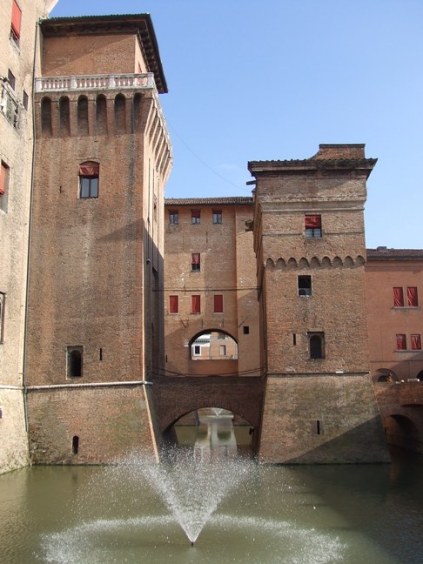About Ferrara
Ferrara is a city in the Emilia-Romagna region of Italy, at the top of Italy’s boot and not far from the eastern Adriatic coast. It is on UNESCO’s World Heritage list. For three centuries the town was ruled by the Este family, whose Renaissance court was among the finest in Italy, attracting artists and writers like Ludovico Ariosto, author of Orlando Furioso.
The town is still enclosed within its 6-mile-long defensive wall, which makes a good cycle route or walk, with grassy parks outside. Not all of the city within the walls is of similar antiquity; if you enter along the wide Viale Cavour you will wonder where the historic buildings are, until you take a side-turning and find yourself in the city’s network of medieval and Renaissance streets. It’s a good idea to explore with a map (available from the tourist information office in the courtyard of the Castello Estense) as these picturesque streets stretch for some way. Unfortunately, only a few lanes are pedestrianised; many of the inhabitants of Ferrara, however, get around on old bicycles, bumping over the cobbles.
Ferrara tourist attractions
The area enclosed by Ferrara’s walls is large but the most of the sights in the historic centre are reasonably close together. There are local buses, although they don’t traverse all the historic lanes.
The Castello Estense was the stronghold of the Este family and sits red-brick, solid and moated in the heart of Ferrara. Although built as a tough fortress in 1385, the Este family also used it as a residence and for entertaining so it contains state apartments as well as dungeons. The castle is open to the public, with its entrance through a ticket office in the courtyard. It’s worth paying an extra euro to climb the Torre dei Leoni, a tower with views over the town centre. Many of the castle rooms are bare, hosting information boards about Ferrara and the Este dynasty. All the signs are in English as well as Italian. Descending to the prison cells is the most atmospheric part of the tour. Low and gloomy, they are accessed through tiny doorways with thick doors attached; if you are alone it’s quite nervy entering. Around the walls are daubs and scratchings said to be by the unlucky people incarcerated here. Prisoners in this castle have inspired poetry and opera: the doomed Parisina and Ugo d’Este, a young wife and her stepson who fell fatally in love; and the two rebel brothers of an Este Duke, who were kept here for decades, one surving to be released after 53 years. Upstairs the highlights include some lovely frescoed ceilings with classical scenes and influences, and the little marble ducal chapel. There is a cafeteria and also rather feeble provision of toilets halfway around the visiting route.
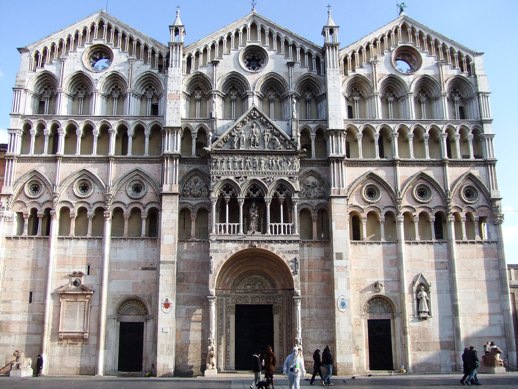
Ferrara’s Cattedrale is close to the Castello Estense, with busy shops, cafes and stalls nearby making it a lively centre for the modern town. The church was consecrated in the twelfth century, although the interior is more recent. The facade is a grand and rather overpowering combination of Romanesque features in its lower half and Gothic in the upper part. The interior is imposing and shadowy; its artistic highlight a depiction of the Last Judgement by Bastianino above the apse, which can be hard to make out in the gloom. The building can be visited free, but is closed for several hours at lunchtime. Close by is the Museo della Cattedrale (admission charge) which contains art and exhibits related to or from the cathedral, including a sculpture by Jacopo della Quercia of the Madonna.
As well as their central residences, the Este family built a network of villas, palaces and retreats in and around Ferrara, known fetchingly as the ‘delights of the Estes’. One of these was the Palazzo Schifanoia, a fifteen-minute walk from the Castle. The name sounds strange in Italian; it come from an expression meaning something like ‘sweep out boredom’. The palace has suffered a great deal of ill-treatment over the centuries and now its facade is simple and plain, with only the grand marble entrance as a reminder of its glory. Inside there are various museum rooms with exhibits of porcelain, patches of fresco and objects of minor interest. The building’s big attraction is upstairs: a cycle of frescoes representing months of the year dating to 1469-1470. Attributed to various artists, half of the frescoes are still in a decent condition and contain marvellous depictions of Renaissance courtly life. Also of interest to the English visitor in particular is an alabaster altarpiece from Nottingham which was apparently a gift from an English king to the Este family. The museum can be visited with a combined ticket including the Museo della Cattedrale, Palazzina Marfisa d’Este and the Lapidario Civico over the road, a small collection of Roman marbles.
Included on the combined ticket, the Palazzina Marfisa d’Este is a one-storey building which doesn’t require much time to visit. It belonged to Francesco d’Este and was inhabited by his daughter Marfisa, who was a patron of the arts. She features as a child in one of the frescoes decorating this ‘little palace’. As well as fresco decorations, some original and some more recent, the rooms contain some antique furniture and portraits.
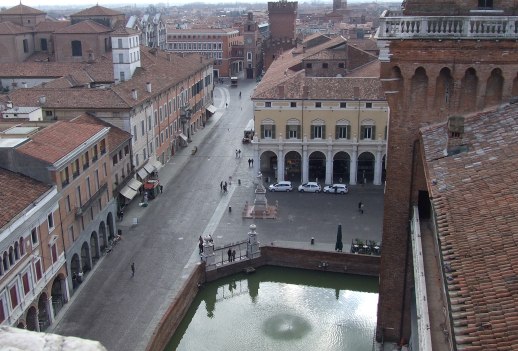
Among Ferrara’s other sights are a number of palazzi and churches. The church of Santa Maria in Vado, close to Palazzo Schifanoia, was the site of a twelfth-century miracle. It’s richly decorated – look out for the bizarre sight of a frescoed figure with three-dimensional legs. Ferrara’s archaeological museum (Museo Archeologico Nazionale) contains Etruscan and Greek finds from a site called Spina in the Po Delta. The glamorously-titled Palazzo dei Diamanti is in fact named for its shaped stonework rather than for gemstones; it was another Este palace and now houses Ferrara’s art gallery, the Pinacoteca Nazionale, which displays works by local artists and masters including Carpaccio and the Bellini family. Visitors can admire more artworks in Palazzo Massari which houses the Museo Boldini. The Casa di Ludovico Ariosto is the house where the poet lived and died; it now contains a small museum. His tomb can be seen at Palazzo Paradiso, which was formerly a university building (and still contains an anatomy theatre) and now houses a library of rare manuscripts. Casa Romei is a Renaissance residence containg frescoes.
Once visitors have taken their pick from Ferrara’s long list of palaces and museums, it is enjoyable as well as interesting to stroll around the town’s central lanes. Different members of the Este family supervised expansions of the city, of which the most renowned is the Addizione Erculea, an exercise in town-planning carried out by Duke Ercole I d’Este at the end of the fifteenth century.
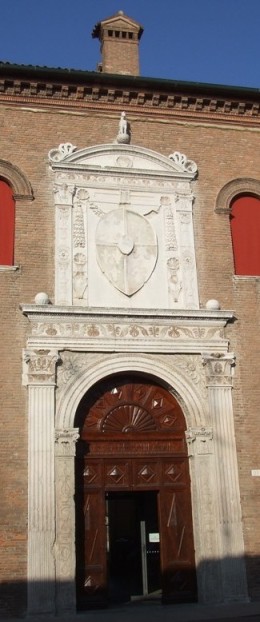
Practicalities
There are quite a few things to see in Ferrara, and you really need at least a couple of days if you want to enter all the palaces and museums open to the public. As usual in Italian towns you should check opening times as some sights are open only in the mornings, others close for lunch and most are closed on a Monday. Check for cumulative tickets (which may be only valid on one day) and for any reductions to which you may be entitled.
There are quite a few little restaurants and bars dotted around the central cathedral area, offering a range of pasta, pizza and lighter snack options. I ate a reasonable pizza for 4 euros at Da Francesco on Via Frizzi, down a side-street by the Castello Estense. On a Sunday afternoon the streets filled with Ferraresi enjoying their winter passeggiata, and most of them seemed to spill into the bustling interior of the Bar Leon d’Oro to chat over hot drinks. Sitting at a table here isn’t cheap but the biscuits and pastries are good.
Events and things to do
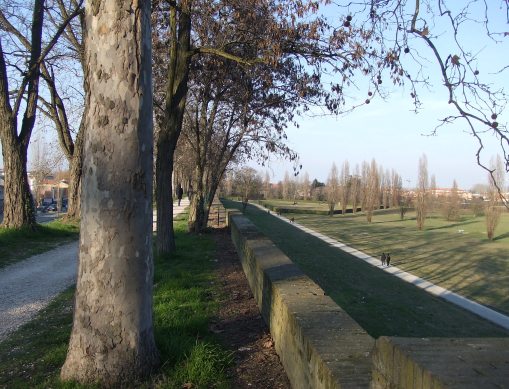
Once a year (generally at the end of August) Ferrara holds a Festival dei Buskers, when the streets fill with buskers of all kinds. In May there is a Palio, a traditional horseback contest between the town’s districts, preceded by processions in historic costumes. There is an antiques market on the first weekend of every month, and on the third weekend there’s a little market of craft stalls.
Ferrara is a good town for cyclists, and tourists can join the locals by hiring bicycles. There are marked cycle lanes and also the long route around the city walls where the active can cycle, jog or walk.
Ferrara travel
Ferrara is on a railway line which connects Venice and Bologna and there are direct regional trains to Venice, which take an hour and a half, making it possible to visit one city as a daytrip from the other.
If you are arriving by train, you can walk into the historic centre on foot, which takes about twenty minutes, or catch a local bus. To walk, leave the ticket hall, cross the main road, walk to the left then follow the busy Viale Cavour around to the right. This street cuts right through town to the Castello Estense. There is a map on a board outside the station to help you get your bearings.
Local city buses in Ferrara are run by a company called ACFT; their timetables (orari) can be viewed on their website (see our links panel).
Around Ferrara
Ferrara’s UNESCO listing includes the Po delta, a large area in which the Po, one of Italy’s most important rivers, empties itself into the Adriatic Sea.
Bologna and Ravenna are each a train ride away, and to the south of Ravenna lies Rimini and a long developed stretch of beach resorts. As well as touring the Emilia-Romagna region, holiday-makers can also explore northwards into the Veneto.
On this site
Useful external links
Castello Estense (includes histories of the Este family, in English)
Emilia-Romagna destinations
- Emilia-Romagna region – an introduction
- Bologna
- Castello di Torrechiara
- Ferrara
- Parma
- Ravenna
- Rimini
